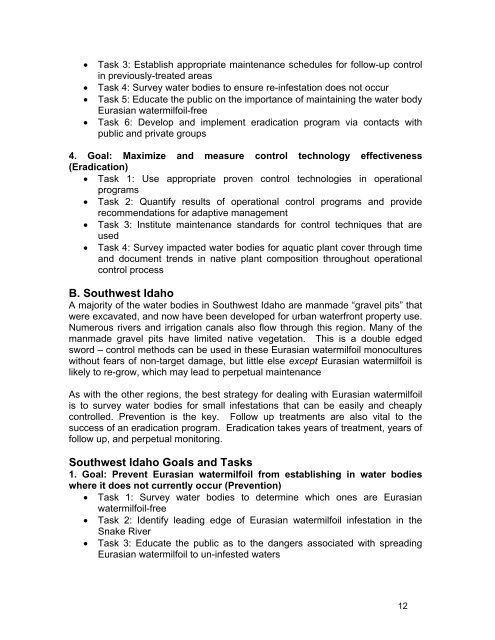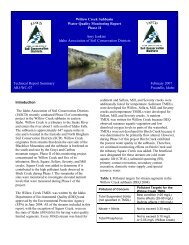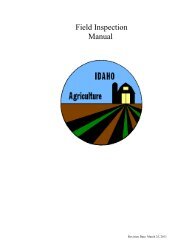2008 Statewide Strategic Plan for Eurasian Watermilfoil in Idaho
2008 Statewide Strategic Plan for Eurasian Watermilfoil in Idaho
2008 Statewide Strategic Plan for Eurasian Watermilfoil in Idaho
You also want an ePaper? Increase the reach of your titles
YUMPU automatically turns print PDFs into web optimized ePapers that Google loves.
• Task 3: Establish appropriate ma<strong>in</strong>tenance schedules <strong>for</strong> follow-up control<br />
<strong>in</strong> previously-treated areas<br />
• Task 4: Survey water bodies to ensure re-<strong>in</strong>festation does not occur<br />
• Task 5: Educate the public on the importance of ma<strong>in</strong>ta<strong>in</strong><strong>in</strong>g the water body<br />
<strong>Eurasian</strong> watermilfoil-free<br />
• Task 6: Develop and implement eradication program via contacts with<br />
public and private groups<br />
4. Goal: Maximize and measure control technology effectiveness<br />
(Eradication)<br />
• Task 1: Use appropriate proven control technologies <strong>in</strong> operational<br />
programs<br />
• Task 2: Quantify results of operational control programs and provide<br />
recommendations <strong>for</strong> adaptive management<br />
• Task 3: Institute ma<strong>in</strong>tenance standards <strong>for</strong> control techniques that are<br />
used<br />
• Task 4: Survey impacted water bodies <strong>for</strong> aquatic plant cover through time<br />
and document trends <strong>in</strong> native plant composition throughout operational<br />
control process<br />
B. Southwest <strong>Idaho</strong><br />
A majority of the water bodies <strong>in</strong> Southwest <strong>Idaho</strong> are manmade “gravel pits” that<br />
were excavated, and now have been developed <strong>for</strong> urban waterfront property use.<br />
Numerous rivers and irrigation canals also flow through this region. Many of the<br />
manmade gravel pits have limited native vegetation. This is a double edged<br />
sword – control methods can be used <strong>in</strong> these <strong>Eurasian</strong> watermilfoil monocultures<br />
without fears of non-target damage, but little else except <strong>Eurasian</strong> watermilfoil is<br />
likely to re-grow, which may lead to perpetual ma<strong>in</strong>tenance<br />
As with the other regions, the best strategy <strong>for</strong> deal<strong>in</strong>g with <strong>Eurasian</strong> watermilfoil<br />
is to survey water bodies <strong>for</strong> small <strong>in</strong>festations that can be easily and cheaply<br />
controlled. Prevention is the key. Follow up treatments are also vital to the<br />
success of an eradication program. Eradication takes years of treatment, years of<br />
follow up, and perpetual monitor<strong>in</strong>g.<br />
Southwest <strong>Idaho</strong> Goals and Tasks<br />
1. Goal: Prevent <strong>Eurasian</strong> watermilfoil from establish<strong>in</strong>g <strong>in</strong> water bodies<br />
where it does not currently occur (Prevention)<br />
• Task 1: Survey water bodies to determ<strong>in</strong>e which ones are <strong>Eurasian</strong><br />
watermilfoil-free<br />
• Task 2: Identify lead<strong>in</strong>g edge of <strong>Eurasian</strong> watermilfoil <strong>in</strong>festation <strong>in</strong> the<br />
Snake River<br />
• Task 3: Educate the public as to the dangers associated with spread<strong>in</strong>g<br />
<strong>Eurasian</strong> watermilfoil to un-<strong>in</strong>fested waters<br />
12
















